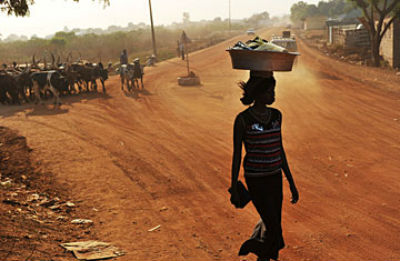![“A pedestrian walks on an unpaved road in Juba, the capital of Southern Sudan on January 11, 2011” [AFP/Roberto Schmidt].](http://www.southsudannewsagency.com/wp-content/uploads/2013/05/aaaa-Juba-AFP.jpg) By Kenyi A. Spencer
By Kenyi A. Spencer
May 13, 2013 (SSNA) — Africa, south of the Sahara, is urbanizing faster than ever in the history of the region. Many of the youth and able-bodied citizens are piling into the only urban centres available leaving the rural areas vacant. This is putting negative strains on our economies. Rural areas are not realizing their high potential in agricultural productivity and, at the same time, the demand for shelter, food, medical services and educational facilities in urban areas is becoming more intense. As regards shelter, rural-standard housing is being transferred to cities, making our cities extensions of the rural sector but that is not the worry. If there are worries elsewhere in the region, in Juba such worries are multiplied. Everyone in Juba aspires to own a city plot whether or not it makes sense. Each and everyone wants to have a plot of his or her own regardless whether it will be developed according to city standards in the next few years or not. But, on the positive end, as people pour into urban areas leaving vacant spaces in the rural areas, government can design a perfect programme to put the vacant land to agricultural use.
This is a topic for another article. It is the influx into cities that is the topic today. It is a problem. At this current rate or expansion, the peripheries of Juba will soon touch Mundri in Western Equatoria by the year 2040 if we do not do something quick to reverse the trend. What’s the quick solution? In the rest of the region as urbanisation is happening at an uncontrollable rate, cities like Nairobi, Kampala and Kigali are condensing, concentrating their people into the smallest space possible. They are going for high-rise apartments and town houses for residences and sky-scrappers for office buildings. Juba should do the same. Unfortunately, Juba does not know its geology so well to allow for such condensation. In the first instance, and geologically speaking, what came first: the Nile or Jebel Kujur? This is a pertinent question. If the Nile was here first it means the whole area ranging from west of Jebel Kujur, all the way to Jebel Bungu, and the present position of the Nile is all alluvial ground – too soft to take high-rises. Even if the area west of the mountain is slated to hold the new Juba, the ground there is a former Nile basin – too weak to take the condensed building. And, if Jebel Kujur was here first then it is only the area east of the mountain, the current position of Juba is the soft area incapable of carrying a real modern city. That means Juba is in the wrong place.
Juba is in the wrong place for two other reasons. In the first place, the elevation of the Nile vis-à-vis Juba is wrong. The Nile at Lologo is 2º higher than the city. Another problem is that the Nile makes a 90º angle at Kassafa. These two factors expose the city to possible flooding once the velocity of the Nile waters surges. This could easily happen since the only ‘artificial’ structure restraining Lake Victoria is the Owen Falls Dam at Jinja in Uganda. That dam is decades only, too old to hold back the lake any longer. If it gives there is nothing between Jinja and Juba that would save the latter. The two degree angle of elevation would allow the river water to splash way above the city and beyond. The Kassafa turn would allow the river water to take a straight line through the town taking anything from Jebel Kujur east-wards downstream. These are the dangers facing Juba if nothing to safeguard the city is done soon. First, we need our geologists to study the Juba basement before we start toying with the devil building city high-rises to accommodate our urban population. This then will indicate to us which side of Juba is suitable for modern development.
It is unfortunate many of us will take this as whimsical fantasies but it is better to listen to warning voices as voices of reason and not interpret them as evil messengers. I have come across arguments of this kind, where explanations of this kind that require our concerted effort to dig up the real facts and act according to them are considered ‘theories’/’non-facts’. At the end of the day it is those who act according to these gestures that reap positive results, or avoid calamities. We need to avoid; or, at the very least, respond to voices of reason and stem such calamities in the future. This is what they call pro-active living. Unfortunately, we are averse to that as a nation.
The Author is an environmental economist, international trade specialist, and private sector development consultant based in Juba, South Sudan.

